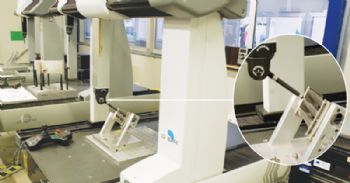
Checking critical dimensions of complex high-volume parts can be difficult and time-consuming, particularly when it is necessary to conduct checks on 100% of parts manufactured.
At Europea Microfusioni Aerospaziali (EMA) — a turbine blade manufacturing company near Avellino, Italy — checking its products using a Renishaw PH20 five-axis probe head (
www.renishaw.com) has cut cycle times by up to 50%, when compared to using a three-axis system.
EMA, which is part of the Rolls-Royce Group, manufactures ultra-high-precision stator and rotor blades in special alloys for high-, intermediate- and low-pressure stage aeronautical turbines used in both civil and
military applications.
The company also makes blades for industrial turbines used to generate electricity. More than two thirds of its production is for prestigious customers in the aeronautical industry in Italy and around the world, including parent company Rolls-Royce, Agusta Westland, Ansaldo Energia, Avio, Turbocare, Siemens, MAN and Snecma.
Indeed, about 25% of the world’s military aircraft are fitted with Rolls-Royce engines — many of which use EMA products.
Turbine and aero-engine blades are made using super-alloys capable of withstanding very high temperatures and pressures.
Their shapes are typically complex, to maximise efficiency and reduce stress and fatigue, yet they are made using one of the oldest manufacturing techniques — casting.
EMA has perfected a wide range of ‘micro casting’ technologies (including those used for the production of blades comprising ‘single crystals’ of metal alloy). The company also specialises in the lost-wax micro-casting process, which begins with making wax models obtained from metal moulds.
These are coated with a ceramic material that forms the mould for the super-alloy when the wax is removed. Once solidified and cooled, the cast parts undergo heat treatment and finishing, and all components are checked for dimensional accuracy, as well as structural integrity, using ultrasound, X-ray and liquid penetrant testing.
Challenging checking
Designing an efficient process for checking the dimensional accuracy of turbine and aero-engine blades is challenging, due to the complex geometry of the part and the need to check every blade.
EMA’s quality control manager, Vittorio Caggiano, said: “With ever increasing production requirements, we had to find a solution that would allow us to improve the efficiency of the dimensional verification process.
“Until a couple of years ago, our CMMs operated with Renishaw PH10 three-axis indexing heads. However, for our type of work, these had certain limitations due to the complexity of the parts, which necessitated many stylus changes for
each measurement cycle.
“We worked closely with technicians at Renishaw’s facility in Turin; after a number of tests, we concluded that the best solution was to use its PH20 five-axis probe heads and MODUS metrology software.
“Renishaw retrofitted the new probes to our existing CMMs; it also created 50 measuring programs while we were undertaking our training on the probe heads.”
EMA CMM programmer Maurizio Rullo said: “Since using the PH20s, we have significantly reduced both measurement times and the number of stylus changes needed, while the use of the MODUS software has optimised the programs and reduced programming times. As a result, we have managed to reduce cycle times by 30-50% — and even more in some cases.”
EMA also invested in a Renishaw Equator flexible gauge, which allows the company to check the geometry and shape of high-volume parts quickly and efficiently.
Mr Rullo said: “Thanks to the Renishaw Equator, we were able to ‘pool’ all the checks necessary on certain components, which we previously performed using multiple gauge instruments. As a result, we significantly reduced the check times of parts produced in high volumes.”
‘Head and software’
The PH20’s unique ‘head touches’ allow measurement points to be taken by moving only the head rather than the CMM structure.
Using only the rapid rotary motion of the head means that points can be taken faster — and with improved accuracy and repeatability. Furthermore, five-axis motion eliminates time spent indexing the head, while the PH20’s ‘infinite positioning capability’ provides optimal feature access and minimises stylus changes.
Moreover, the five-axis simultaneous motion offered by this probe head allows larger parts to be measured on the CMM by minimising the space required around the part for head rotation — and the PH20 automatically aligns itself with the part co-ordinate system, avoiding stylus collisions and the requirement for accurate fixtures.
Furthermore, the ‘inferred calibration’ technique developed specifically for the PH20 determines the head orientation and probe position in a single operation, allowing subsequent measurement at any head angle.
Meanwhile, the MODUS metrology software simplifies the programming of complex measuring cycles; it also allows the off-line development of advanced programs directly from CAD, with simulation, collision detection and screen-checking functions of the probe path.
This minimises machine down-time, as the programs reach the machine ready for use, and testing times are reduced to a minimum — or eliminated altogether.